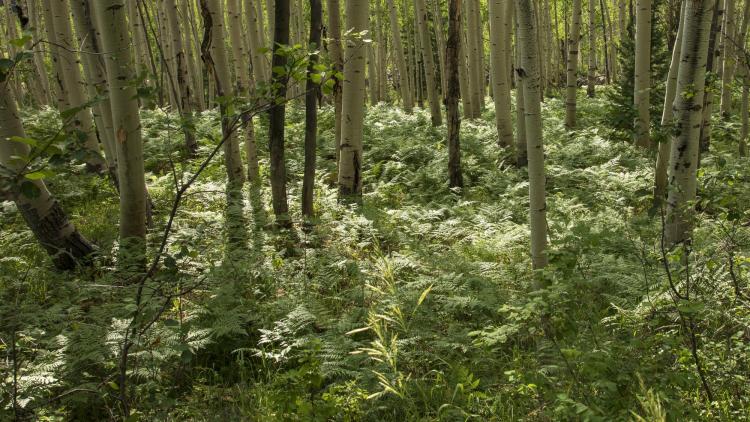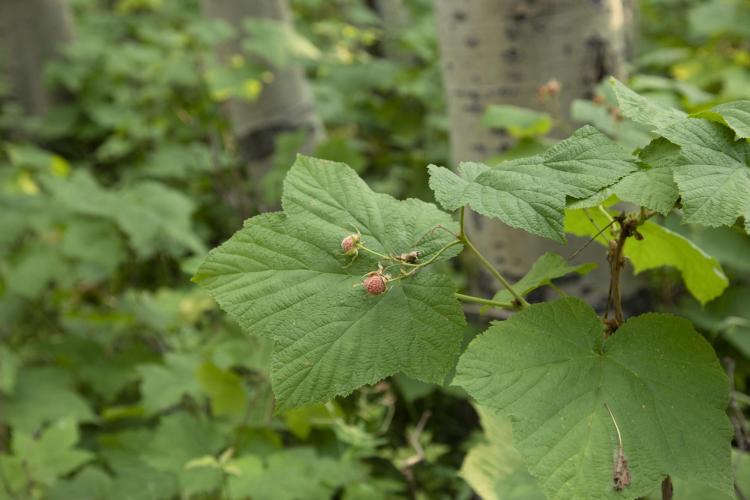Understories of quaking aspen vary dramatically among habitats
An understated characterization of quaking aspen is that it grows in many different plant communities, in many different ways and has adapted to an extremely wide range of environments
From Horse Park Ranch, on the west side of the Ruby Mountains, Dark Canyon Trail threads its way through the allegedly largest stand of quaking aspen, Populus tremuloides, in North America. On my way to an overlook of Dark Canyon in the Raggeds Wilderness, I noticed how aspen communities changed from place to place. At one point, I was distracted by a lush layer of hairy bracken fern, Pteridium aquilinum. But a few hundred yards along the trail I was struck by an understory of two to five feet tall thimbleberry shrubs, Rubus parviflorus. A quick search of the memory banks recalled sites with aspen above Gambel oaks in the San Juan Mountains, in sagebrush on Blue Mesa and above corn lilies or false hellebore near Gothic.
Quaking aspen is the most geographically widespread deciduous tree in North America. Its natural distribution reaches from Nome, Alaska to Newfoundland and Nova Scotia, to the Sierra Nevada in California and the Mexican Plateau. It grows in all portions of the Rocky Mountains and most of the mountain ranges in the Great Basin. Aspen grows naturally from sea level at the Bering Sea and the Atlantic Ocean to 11,300 feet on Niwot Ridge in Colorado. Across this immense range and great diversity of environments, it is associated with many other species. For example, within Colorado, aspen grows in stands of ponderosa pine, lodgepole pine and Douglas-fir, and also in spruce-fir forests. Aspen grows in arid sites dominated by sagebrush and also in continually moist sites beside creeks and rivers.

At the top of the page: Clones of aspen with striking colors above Horse Park Ranch. Above: Bracken fern beneath aspen. Photos by Jeff Mitton.
After major disruptions such as fires, avalanches and insect epidemics, plant communities change over time, a process known to community ecologists as succession. Aspen has an advantage after disturbances that destroy living tissue above ground but leave root systems intact--young stems appear promptly from aspen roots running just below the surface. In most environments, aspen is either an early or mid-successional species, while in some environments, aspen is the end point of succession, a climax species.
To better understand the ecology of aspen, plant ecologists grouped stands of aspen by species in their understory communities. These studies employed dozens of species to resolve stands of aspen into seven geographic zones in western North America: Northern Great Plains, Sierra Nevada, Black Hills, Colorado Plateau, and Northern, Central and Southern Rocky Mountains. While this study revealed large areas in which aspen communities were somewhat similar and less similar to communities in other zones, it does not summarize all of the variation -- important and conspicuous variation was left for ecologists looking at smaller geographic scales.
Aspen stems vary dramatically from place to place."
A study of aspen in the Routt National Forest in north central Colorado characterized understory communities beneath aspen. The Routt National Forest is entirely within and is much smaller than Southern Rocky Mountains zone. This study resolved five communities, named by their most conspicuous understory species: snowberry (a woody shrub with white, pendant bell-shaped flowers producing white berries, Symphoricarpos oreophilus); meadow rue or false columbine (leaves similar to columbine but with pendant flower parts, Thalictrum fendleri); cow parsnip (growing over six feet tall with enormous palmate leaves and tiny flowers in flat umbels up to a foot across, Heracleum sphondyllium); corn lilies or false hellebore, (growing to seven feet, with an enormous plume of tiny greenish-white flowers above a stalk bearing leaves up to a foot long, Veratrum tenuipetalum) and hairy bracken fern (growing to three feet tall with triangular fronds, Pteridium aquilinum). This study revealed the sort of variation that I saw along the Dark Canyon Trail.
Aspen stems vary dramatically from place to place. In early succession, the stems are short but densely packed, while climax stands have thick, tall and widely spaced stems. Some clones must grow tall to get to the top of the canopy and these have slender stems without branches until the tuft of branches and leaves at the top. In contrast, clones in sagebrush are much shorter, with many branches. Bark colors, produced by photosynthetic pigments, vary among clones from white to green and brown. In western states, arid environments favor asexual reproduction via spreading from roots, forming clones, while in eastern states more mesic environments favor sexual reproduction, so aspens grow as independent stems, without clones.
An understated characterization of quaking aspen is that it grows in many different plant communities, in many different ways and has adapted to an extremely wide range of environments. It seems that every stand of aspen is unique so that hiking in an aspen forest is always a fresh experience--I suppose that is part of aspen's charm.

Thimbleberry grew as a thick understory, two to four feet tall. Photo by Jeff Mitton.

